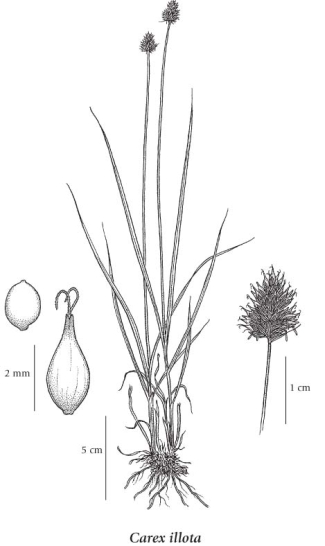Carex illota L.H. Bailey
sheep sedge
Cyperaceae (Sedge family)
Introduction to Vascular Plants
sheep sedge
Cyperaceae (Sedge family)
Introduction to Vascular Plants
Species Information
General:
Perennial, tufted herb from fibrous roots; stems 10-35 cm tall, exceeding the leaves.
Leaves:
Sheaths tight; blades flat, 1-3 mm wide, borne on the lower 1/3 of the stem, the lowermost stem leaves reduced to scales.
Flowers:
Spikes 3 to 5, aggregated into a dense 0.5- to 1.5-cm long ellipsoid head, unstalked, with both female and male flowers, the female ones towards the tips; bracts subtending the spikes sheathless, reduced, inconspicuous.
Fruits:
Perigynia narrowly egg-shaped, 2.5-3.5 mm long, 1.3-1.5 mm wide, brownish to dark brown, more or less flattened, the margins with narrow wings, lightly several-nerved on the backs, with faint nerves or nerveless below, the beaks shallowly bidentate, about 1.5 mm long, narrowly margined, sometimes toothed; female scales elliptical, dark brown, somewhat shorter and narrower than the perigynia, margins smooth; stigmas 2; achenes lens-shaped, 1.2-1.5 mm long.
Illustration

If more than one illustration is available for a species (e.g., separate illustrations were provided for two subspecies) then links to the separate images will be provided below. Note that individual subspecies or varietal illustrations are not always available.
Illustration Source: The Illustrated Flora of British Columbia
Ecology
Ecological Framework for Carex illota
The table below shows the species-specific information calculated from
original data (BEC database) provided by the BC Ministry of Forests and Range.
(Updated August, 2013)
The table below shows the species-specific information calculated from
original data (BEC database) provided by the BC Ministry of Forests and Range.
(Updated August, 2013)
| Site Information |
Value / Class |
||
|
Avg |
Min |
Max |
|
| Elevation
(metres) |
1751 | 822 | 2453 |
| Slope
Gradient (%) |
4 | 0 | 40 |
|
Aspect (degrees) |
195 | 2 | 360 |
| Soil
Moisture Regime (SMR) [0 - very xeric; 4 - mesic; 8 - hydric] |
6 | 4 | 8 |
| Modal
Nutrient Regime
Class |
D | ||
| #
of field plots species was recorded in: |
93 | ||
| Modal
BEC Zone Class |
ESSF | ||
|
All BEC Zones (# of stations/zone) species was recorded in |
CWH(1), ESSF(83), IDF(1), MH(2), MS(4), SBS(1), SWB(1) | ||
|
Source:
Klinkenberg 2013
|
|||